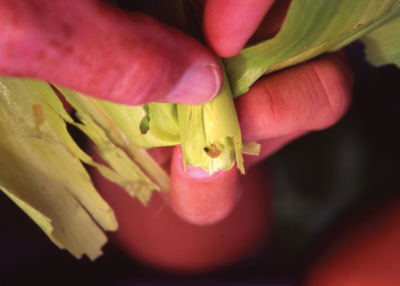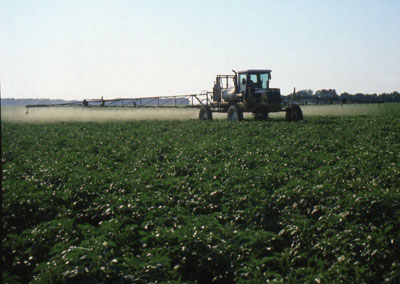
Features
Agronomy
Insect Pests
Potato growers have new way to control European corn borer
Cool, wet weather conditions made it very difficult for Maritime potato growers to control European corn borer (ECB) in the summer of 2008.
April 30, 2009 By Potatoes in Canada
 |
| The potential for European corn borer, seen here in a corn stalk, to cause significant yield loss in potatoes is present from year to year.
|
Cool, wet weather conditions made it very difficult for Maritime potato growers to control European corn borer (ECB) in the summer of 2008. Moth emergence, appearance of egg masses and hatch were each spread out over several weeks making it almost impossible to control ECB with a single pass of contact insecticides. Crop protection dealers had a hard time finding enough supply of insecticides with long-lasting residual control, like new DuPont Coragen and its active ingredient Rynaxypyr, to meet the demand. “Corn borers are recognized as serious insect pests in areas of Maine, New Brunswick, and Prince Edward Island,” says Dr. Robert Coffin, a crop specialist with Cavendish Farms in Prince Edward Island. “While they won’t devastate every potato field every year, the potential for them to cause significant yield loss is always there.”
“ECB overwinters in the soil and on the soil surface on trash, such as potato and corn stems,” says Steve Howatt, president of Atlantic Agritech, in New Glasgow, PEI. “In the spring or early summer the adult corn borer moths emerge, mate, and the females lay eggs on the stems, or the leaves, of suitable host plants. After a period of incubation the eggs will hatch and the small larvae will bore into the stems and start feeding.”
Larvae are very small, only about 2 millimetres in length when they hatch, but they can become quite large, more than 3.5 centimetres (nearly 1.5 inches) by the end of the growing season. Having insects that grow to this size eating away inside a stem can seriously weaken plant structure. Feeding activity alone can sometimes affect yield by reducing the plant’s ability to take up water and nutrients but they only cause serious yield losses when the weakened stocks break off in the wind.
ECB is not a big problem if the stems do not break off. Unfortunately growers do not know in advance if there will be enough high winds in late summer to cause a large amount of damage. Coffin says that tests at Cavendish Farms have shown that in seasons where significant breakage occurs, spraying insecticides will prevent yield losses. Since growers know damage can be severe, most prefer to err on the side of caution. They opt to spray rather than gamble on light winds if there is significant evidence of moths and egg masses in a field.
Still, it is not easy to know if there are enough in any given field to justify spraying. Egg masses are inconspicuous. They are flat, creamy white and layered over each other. They look a lot like fish scales clinging to the plant’s stem or leaves. Since they are difficult to spot it is very hard to evaluate how many are there. Crop scouts use pheromone traps to help gauge adult moth numbers. Once they start finding moths they start looking for egg masses. Whenever they find one they will typically mark its location with a piece of coloured tape and monitor its development. Once the egg masses change from a creamy white colour to a dark colour, the eggs are about to hatch.

|
| Products such as Coragen provide a wider window on applications and better residual control, all in one pass.
|
ECB moths will lay eggs over an extended period of time, anywhere from three to five weeks, but there can be a period when egg laying is particularly intense. Ideally a producer can determine when this maximum egg-laying period occurs and time insecticide applications to coincide with the larvae hatch. Timing is critical because they only stay on the outside of the plant for a day or two before they burrow inside. “Timing can drive growers crazy,” Coffin says. “A scout can go out week after week and never find quite enough egg masses at any one time to justify spraying. Cumulatively though, over the course of the summer, enough can hatch to cause a lot of damage. That’s why a product with good residual is so very important. It takes the stress out of trying to pinpoint exactly when you’d have to spray if you use a product that will only last for a short time on the leaf surface.”
“In the past, growers have had to resort to spraying multiple times to make sure they have the appropriate timing,” Howatt adds. “Over the past few years our company has looked at products such as Coragen, that have longer residual activity. Products that remain active on the leaf surface longer provide a bigger window of control with a single application. These products, in conjunction with basic growing degree models that help to predict the hatch more accurately, provide tools that help growers minimize pesticide applications.”
After doing a number of trials with Coragen during the past five years, Howatt said that in some seasons one application of a residual product can control both Colorado potato beetle and European corn borer. Growing season variability is always a wild card, but if the weather co-operates both insect species will emerge within a few days of each other. When this occurs, one well-timed application could effectively control both of them.
DuPont recommends that growers apply Coragen as soon as they start seeing egg masses. Unlike most insecticides it has ovicidal activity. This means it will start to kill corn borer larvae while they are still inside their eggs. It is particularly effective on freshly hatched neonates and its long-lasting activity means that it will still be around to control possible later hatches.
The active ingredient in Coragen is Rynaxypyr. Coragen is in a new chemical class with a new mode of action, Group 28, anthranilic diamide. Since this product works in a different way than others on the market, it provides growers with an effective new tool to control resistant insect populations. It also gives producers an effective new insecticide that they can incorporate into their insect resistance management programs. “Coragen has a long period of activity on the plant surfaces,” Coffin says. “It breaks down, or degrades, very slowly from rainfall, sunlight or oxidation. Farmers were very interested when they heard of this and used a very substantial quantity for corn borers in 2008. The farmers who used it for corn borer seemed to be genuinely happy with its performance.”